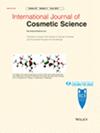Indirubin as a red hair Colourant from Indigofera tinctoria L.
Abstract
Objective
Detailed understanding of the indigo and indirubin synthesis pathway to control their formation and the corresponding colour result on hair should be obtained. Managing the formation of the dye molecules indigo and indirubin the characteristic colour shift which takes place within the days after application of Indigofera tinctoria L.-based hair colouration should be eliminated. Thus, intense, more reliable and stable colour results on hair from the natural resource I. tinctoria L. are achieved offering benefits to the consumer resulting in higher acceptance of plant-based colouration products.
Methods
Various colourations with I. tinctoria L. crushed leaves powder and cysteine, isatin or ascorbic acid on yak hair strands were carried out at room temperature or 37°C. Colour assessment was conducted with L*-, a*-, and b*-values/coordinates of three-dimensional CIE-Lab-colour. Coloured hair strands were pulverized with a ball mill to extract dyeing compounds from hair fibres with either a mixture of ultrapure water and acetonitrile or dimethyl sulfoxide at 80°C. Afterwards, the supernatant was collected, and dyeing compounds were quantified via high-performance liquid chromatography.
Results
It was proven that delayed development of indirubin in addition to the directly formed indigo molecule leads to the observed colour shift on hair fibres when dyeing them with I. tinctoria L. Further, a previously unseen, immediate formation of a stable red colour result was achieved by introducing isatin and cysteine or ascorbic acid to the dyeing procedure. By extraction and subsequent analysis of the dye molecules from the coloured hair fibres, it was confirmed that the addition of isatin and a reducing agent to indigo dyeing prevents the formation of the indigo molecule and favours the formation of indirubin.
Conclusion
Based on the findings, including the instant formation of indirubin instead of the indigo molecule in the presence of isatin and cysteine or ascorbic acid causing an immediate stable red colour result after the application of I. tinctoria L. on hair, a revised indigo and indirubin synthesis pathway for I. tinctoria L. application including the effect of said additives to the colour outcome is presented.


 求助内容:
求助内容: 应助结果提醒方式:
应助结果提醒方式:


